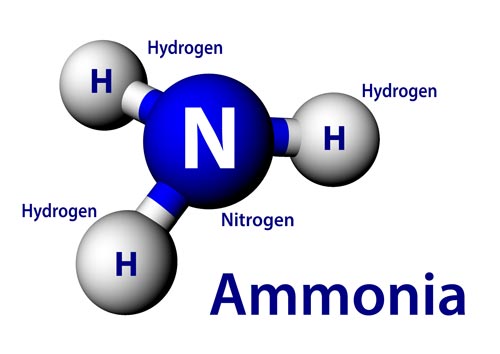Ammonia (NH3) is a colourless, highly toxic gas with a pungent odour. It is a non-flammable gas at low concentrations (less than 15% by volume in air), but it can become flammable at higher concentrations. It is also corrosive and can cause serious health problems if inhaled.
Hazards caused by the chemical can include:
- Fire and explosion: This gas can become flammable at concentrations above 15% (by volume in air). It can also explode if mixed with other flammable substances, such as hydrogen (H2) or methane (CH4).
- Corrosion: It is corrosive to metals and can damage equipment.
- Health problems: Inhaling high concentrations of this chemical can cause respiratory problems, such as coughing, wheezing, and shortness of breath. It can also cause eye irritation, and skin burns, and create problems with the central nervous system.
Ammonia as a By-product

The food industry is another large producer of ammonia, especially businesses that create a lot of nitrogenous waste, such as livestock or poultry farming.
It is also produced industrially for a variety of uses, including fertilisers, explosives, and cleaning products.
The Haber-Bosch process is the most common method for industrially producing the chemical. This process involves reacting hydrogen and nitrogen gases at high pressure and temperature in the presence of a catalyst.
Applications of Ammonia
Whether in its liquid or gas form, ammonia is a common industrial chemical which is used in a variety of applications across a wide range of sectors. Its main uses include:
- Solvent: In its liquid form, ammonia can be used as a cleaning solvent that dissolves ionic compounds such as nitrites and alkali metals like calcium and barium.
- Fertiliser: It is an important crop nutrient. It can be added to fertiliser solutions in wheat and maize farming, for example.
- Refrigerant Gas: Ammonia gas is commonly used in refrigerators, as it is eco-friendly.
- Water Purification: Liquid ammonia is a common drinking water treatment.
- Plastic Manufacturing: Ammonia is used to produce some types of plastic.
- Pharmaceutical Production: It is frequently used in the pharmaceutical industry as a disinfectant or a neutralising agent to inhibit the proliferation of bacteria.
- Clinical Applications: In medical contexts, this gas is commonly used to prevent loss of consciousness and fainting.
- Oil and Gas Processing: Ammonia is sometimes used during oil and gas production to neutralise acidic compounds.
- Mining: In the mining industry, this chemical is used to extract metals such as nickel and copper.
- Energy Production: Coal and oil-fired power stations use ammonia in their reactors to detoxify nitrogen oxides in the smoke, turning them into nitrogen and water.
Controlling Ammonia Risks
There are several things that should be done to control the risks associated with ammonia, including:
- Proper storage: This chemical must be stored in a safe location well away from sources of heat or ignition.
- Training & Handling: It should only be handled by fully trained staff wearing appropriate safety gear.
Health and Safety Considerations
If you work in an industry that produces or works with ammonia, it is important to be aware of the risks and to take steps to protect yourself from exposure. You should also be familiar with the emergency procedures in place in case of a leak or spill.
Here are some tips for preventing ammonia exposure:
- Use personal protective equipment (PPE), such as gloves, goggles, and a respirator.
- Ventilate areas where ammonia is used or stored.
- Keep containers closed tightly and away from other chemicals.
- Do not mix ammonia with other chemicals, as this could create hazardous fumes or other unpredictable dangers to health.
If you experience any symptoms of ammonia exposure, such as coughing, wheezing, shortness of breath, or eye irritation, you should seek medical attention immediately.
Monitoring Ammonia
To reduce the risk of harm, it is necessary that any company involved in ammonia production or use installs fixed gas detectors and ensures employees are using a properly configured portable gas detector, which will continuously monitor for its gas level in the air.
At Rockall Safety, we offer a range of reliable, cost-effective gas detection products to help you ensure that ammonia gas levels are not exceeded in your workplace. Check out the Honeywell BW Solo Single Gas Detector and Dräger PAC 8000 Gas Detector which can be configured to detect this chemical.
For further information, call our team of qualified advisors at 02920 759 683
Sources & Acknowledgements:
Crowcon’s The Complexities of Monitoring Ammonia white paper
https://www.britannica.com/technology/Haber-Bosch-process
Author / Editor
Len Bridgeman – Sabrina Toumi





